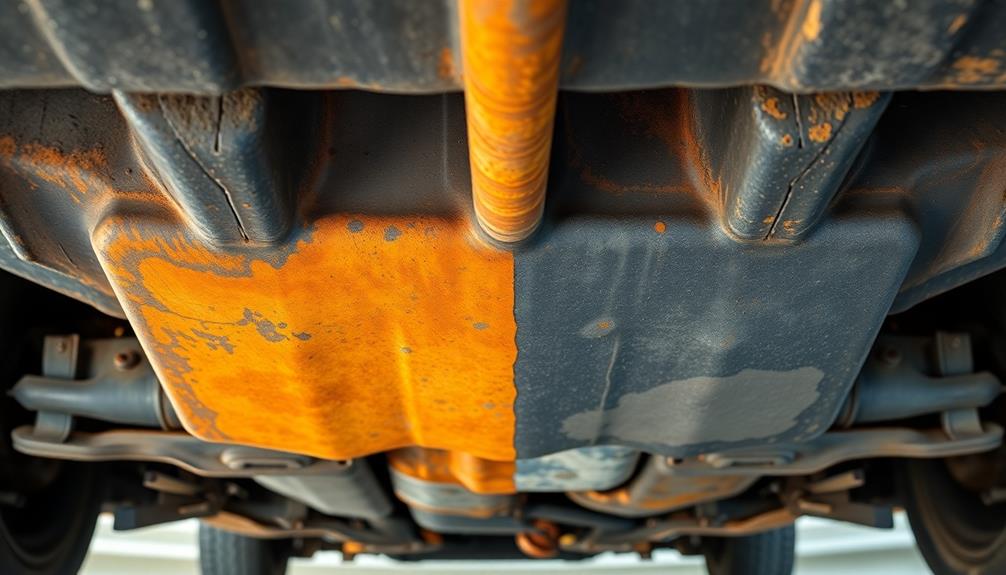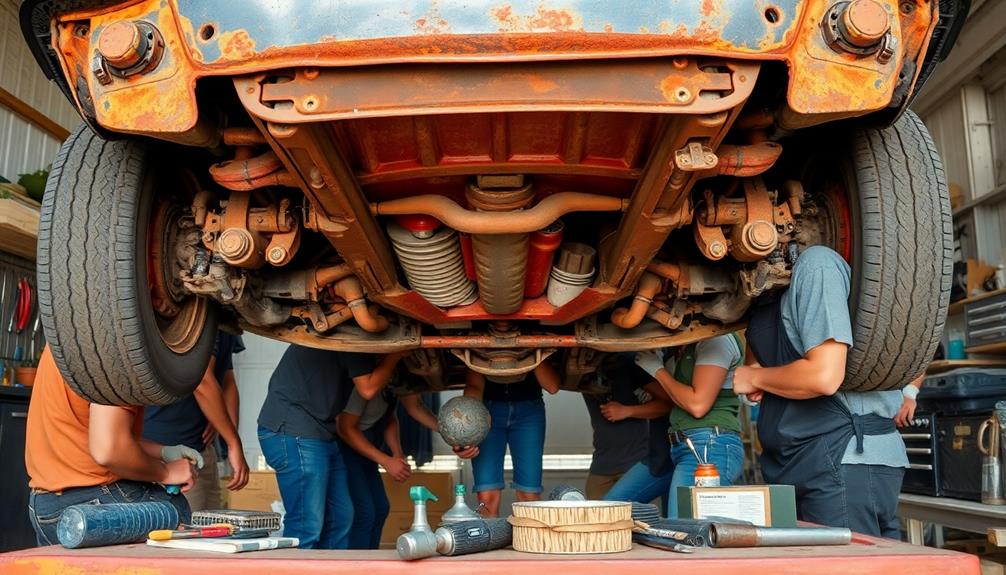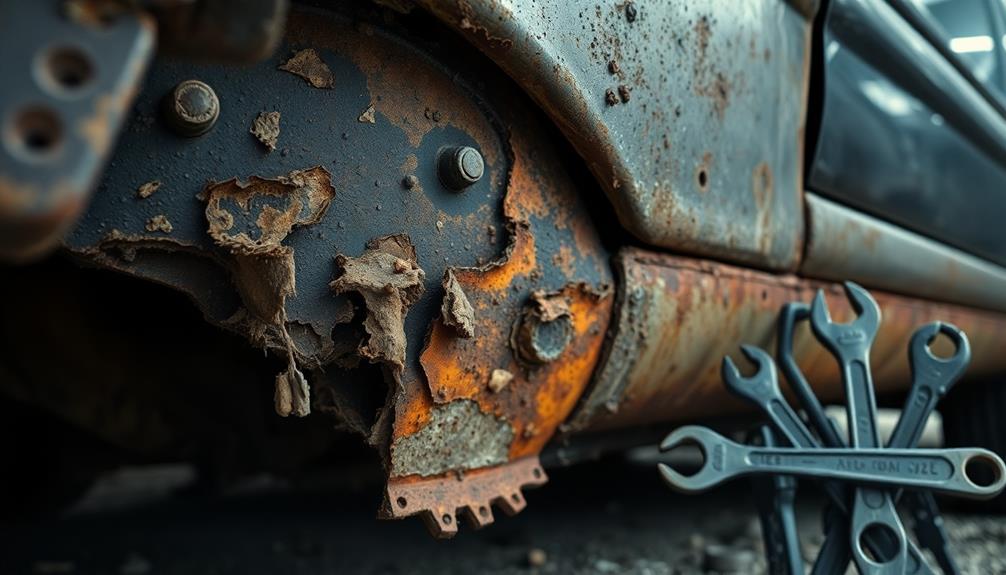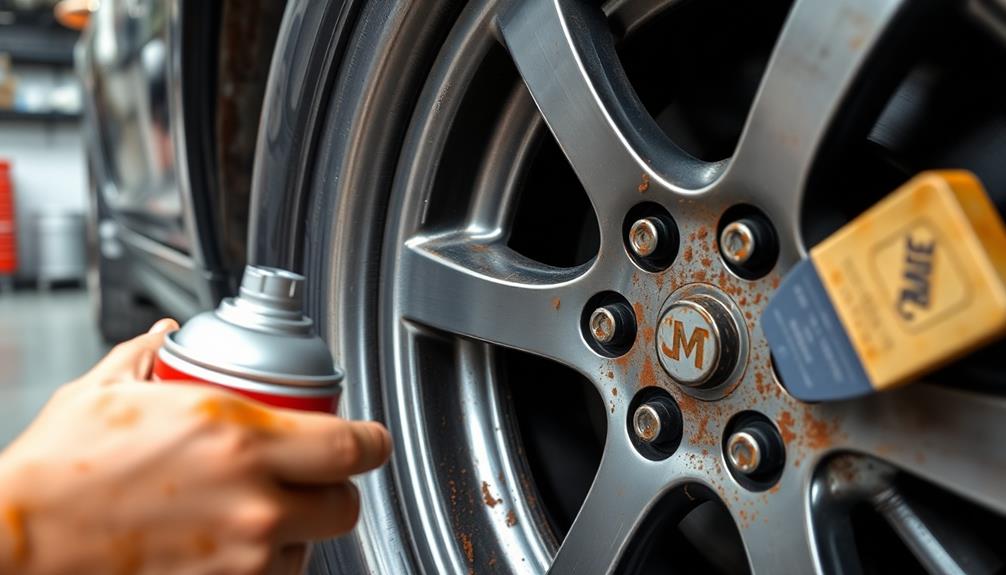Underbody rust is stealthy, often hiding in areas mechanics don't check. It forms from trapped moisture at critical points like inner fender panels and jack points. Surprisingly, factory undercoating can exacerbate the problem by sealing in moisture, making rust worse. Early signs, such as nicks or peeling undercoating, are easy to overlook, but ignoring them can lead to serious damage. Furthermore, simply applying Bondo over rust won't fix the issue; you need proper sealing techniques. By understanding these truths, you can take proactive measures to protect your vehicle. There's more to uncover about effective strategies against underbody rust.
Key Takeaways
- Factory undercoating can trap moisture, accelerating rust formation instead of preventing it, contrary to common belief.
- Peeling undercoating is a warning sign of trapped moisture and potential hidden rust problems.
- Ignoring early signs of rust, like nicks and discoloration, can lead to severe structural issues.
- Bondo is not a long-term solution; it can trap moisture and worsen existing rust if not properly sealed.
- Regular inspections and effective sealing techniques are essential to prevent moisture infiltration and maintain vehicle integrity.
Understanding Rust Formation

Understanding how rust forms is essential for maintaining your vehicle's longevity. Rust formation primarily happens due to moisture exposure, especially in areas where water can easily accumulate. Think about spots like the inner fender panels and jack points, where moisture can linger, creating the perfect breeding ground for rust.
You should pay close attention to early signs of rust, such as nicks and scratches on the underside and rocker panels. If you don't address these issues promptly, they can escalate into more extensive damage over time.
Regular inspections are key—use scraping and probing tools to identify the severity of any rust you find.
Focus your visual inspections on areas prone to moisture accumulation. These spots are critical indicators of potential rust development and help you gauge how quickly rust formation might progress.
Common Undercoating Misconceptions

You might think that factory undercoating keeps your vehicle safe from rust, but it can actually trap moisture and speed up corrosion.
If you notice peeling undercoating, it's a sign that rust could be lurking underneath, causing damage.
Ignoring these issues could lead to bigger problems down the road, so it's crucial to understand the real risks of undercoating.
Moisture Trapping Effects
Many vehicle owners overlook the moisture trapping effects of undercoating, believing it solely protects against rust. However, this misconception can lead to serious issues. Factory undercoating can inadvertently trap moisture against metal surfaces, creating a perfect environment for rust to thrive.
Here's a quick look at how undercoating can affect your vehicle:
| Type of Rust | Moisture Trapping Effects | Regular Inspection Importance |
|---|---|---|
| Surface Rust | Forms when moisture is trapped | Check for early signs |
| Scale Rust | Can develop under trapped moisture | Inspect peeling areas |
| Pitting Rust | Accelerated by sealed moisture | Look for rust spots |
| Corrosion | Grows in hidden, moist areas | Maintain undercoating |
Applying undercoating over existing rust seals in moisture, making the problem worse. Many believe that undercoating is a foolproof solution, but it can exacerbate existing issues if not properly managed. Regular inspection and maintenance of undercoating are essential to prevent rust growth. Ignoring these factors can lead to severe damage, costing you more in the long run. Don't let misconceptions about undercoating jeopardize your vehicle's health!
Peeling Undercoating Risks
Peeling undercoating poses significant risks that can compromise your vehicle's integrity. When you notice peeling, it often means there's trapped moisture underneath, which accelerates rust formation instead of preventing it. This moisture can lead to serious corrosion issues that may go unnoticed until it's too late.
Factory undercoating can hide existing rust problems, making it challenging to identify and address corrosion effectively. If you or your body shop sprays new undercoating over areas with rust, you're sealing in the moisture and worsening the situation. This misguided approach doesn't eliminate the rust; it allows it to fester beneath the surface.
Many body shops lack the expertise to adequately tackle rust issues hidden beneath peeling undercoating. As a result, you might face inadequate repairs that lead to recurring rust problems.
To truly prevent rust, it's essential to perform a thorough inspection and treatment of any affected areas before applying undercoating. Without proper preparation, you could inadvertently exacerbate rust issues, leaving your vehicle vulnerable.
Early Signs of Rust

Rust can creep in silently, but recognizing its early signs is essential for maintaining your vehicle's integrity. You should make sure to inspect the underside and rocker panels for any small nicks or scratches. These minor damages can trap moisture, promoting rust development.
Pay special attention to areas prone to moisture, like inner fender panels and jack points. Look for discoloration or flaking, which can indicate that rust is starting to form.
Don't underestimate the importance of scraping and probing these rust-prone areas with tools. Hidden corrosion often lurks beneath the surface, and a thorough inspection can reveal its severity.
Regular visual checks focusing on metal thickness can provide insight into rust progression, allowing you to address issues before they escalate.
Addressing the early signs of rust is a big deal. If you ignore them, untreated rust can lead to larger holes and structural problems, greatly compromising your vehicle's safety.
Keep a watchful eye and take prompt action to preserve your car's integrity, ensuring it remains roadworthy for years to come.
Effective DIY Repair Techniques

When tackling underbody rust, identifying the affected areas is your first step.
You'll want to explore various repair products and effective sealing techniques to guarantee a long-lasting fix.
Let's break down the best methods to keep your vehicle safe from rust damage.
Rust Identification Methods
To effectively tackle underbody rust, you'll want to start with a thorough inspection of areas where moisture tends to accumulate, such as inner fender panels and jack points.
Use scraping and probing techniques to detect early signs of rust. Pay close attention to nicks and scratches on the underside and rocker panels, as these imperfections can signal potential rust development that needs immediate attention.
Once you identify rust-prone spots, measure the metal thickness in those areas. Thinner metal indicates advanced deterioration, which may require more extensive repairs.
Implementing effective rust identification methods will help you stay on top of rust issues before they escalate.
When you find rust, consider using rust conversion coatings instead of standard paints for your repairs. These coatings are specifically designed to halt rust progression and provide better long-term protection.
Remember, thorough cleaning is essential before applying any sealant, as effective sealing is vital to preventing moisture from infiltrating and causing further rust issues.
Repair Product Options
After identifying rust-prone areas during your inspection, selecting the right repair products becomes a key part of your maintenance strategy. Start with rust conversion coatings, which chemically convert rust into a stable compound, halting further deterioration. Be sure to clean the rusted areas thoroughly, as contaminants can hinder effectiveness.
Next, consider using Bondo for minor surface repairs. However, keep in mind its porous nature can trap moisture. Always seal properly with a moisture barrier to prevent exacerbating rust issues.
Finally, apply Miracle Paint as a sealing solution. This product provides a durable barrier against moisture, greatly extending the lifespan of your repairs.
Here's a quick reference table to assist you in choosing the right products:
| Product Type | Key Benefits | Application Notes |
|---|---|---|
| Rust Conversion Coatings | Stops further rust deterioration | Clean area before application |
| Bondo | Good for minor surface repairs | Must be sealed properly |
| Miracle Paint | Durable moisture barrier | Apply after Bondo or coatings |
Using these products effectively can greatly enhance your underbody rust repair efforts.
Sealing Techniques Explained
Effective sealing techniques are essential for preventing rust from returning and causing more damage. When tackling rust, the first thing you've got to do is clean the affected areas thoroughly. Residual rust or debris can compromise the sealant's effectiveness, leading to further rust issues.
Once you've cleaned the area, consider using rust conversion coatings instead of standard paints. These coatings chemically convert rust into a stable surface, making it easier to seal.
After applying the rust conversion coating, you can use rock-hard sealants like Miracle Paint. These sealants create a durable barrier that prevents moisture from penetrating metal surfaces, greatly reducing the likelihood of future rust formation.
Remember, proper sealing techniques involve treating all rust spots and ensuring they're sealed tightly to block moisture. If sealing isn't done right, you risk trapping water and exacerbating rust problems.
Early intervention with effective sealing methods is vital. Untreated rust can escalate into larger, more costly damage if not addressed promptly. By following these sealing techniques, you can protect your vehicle's underbody and extend its lifespan.
Importance of Proper Sealing

Proper sealing is vital for preventing moisture from reaching metal surfaces, which helps inhibit rust development and extends your vehicle's lifespan. When you apply effective sealing techniques, you create a barrier that protects against moisture infiltration, a key factor in rust formation.
Using rock-hard sealants guarantees long-lasting protection, keeping your vehicle's underbody safe from the elements. One reliable option is Miracle Paint. When applied correctly on thoroughly cleaned rusted areas, it provides excellent rust protection.
By addressing rust issues early with proper sealing, you can markedly reduce the risk of extensive damage that often leads to costly repairs down the line. Neglecting to seal treated areas can have dire consequences.
Moisture can penetrate through unsealed spots, worsening existing rust issues and creating new ones over time. This is why it's important to prioritize proper sealing in your vehicle maintenance routine.
Limitations of Bondo

While sealing is important for preventing rust, relying on Bondo for rust repair comes with significant limitations. Bondo is porous, which means it can allow moisture to seep through, potentially exacerbating rust growth beneath the repair area.
If you apply Bondo over rust without properly treating and sealing the underlying problem, you're likely to trap moisture, worsening the rust issues instead of resolving them.
Before you even think about using Bondo, it's essential to effectively clean and seal the rusted area. If you skip this step, the Bondo could fail, leading to rust re-emerging.
In addition, Bondo isn't a corrosion-resistant material, so it won't provide long-lasting protection against moisture, which is vital for preventing rust in the first place.
For effective rust repair, it's best to use rust conversion coatings and reliable sealing techniques instead of depending solely on Bondo.
While Bondo can fill in holes and provide a temporary fix, it won't cut it when it comes to the long-term health of your vehicle.
Prioritize proper sealing and rust management to keep your vehicle safe from further damage.
Inspection Methods for Rust

Inspecting your vehicle for rust is vital to maintaining its longevity and safety. Regular inspections should include scraping and probing with tools in areas prone to moisture accumulation, like inner fender panels and jack points. These inspection methods help you identify early signs of rust before they escalate into larger problems.
Start with a visual inspection, focusing on nicks and scratches on the underside and rocker panels. These small imperfections can lead to rust, so catching them early is important.
Don't forget to check the metal thickness; this can reveal the severity of any corrosion present and give you insight into rust progression.
Pay attention to areas where water can accumulate or become trapped, as moisture exposure is a key factor in rust formation. Conducting thorough inspections at regular intervals will help prevent small rust issues from becoming significant damage.
Rust Management Resources

When it comes to managing rust, you've got a wealth of resources at your fingertips.
Community support networks, online repair guides, and educational workshops can all help you tackle rust issues confidently.
Community Support Networks
Community support networks play an essential role in empowering individuals to tackle rust issues effectively. By connecting with fellow DIY enthusiasts, you can access valuable resources that enhance your rust repair techniques.
Here are four key benefits of engaging with these networks:
- Access to Manuals and Guides: Organizations like Mercedes Source provide extensive resources focused on rust repair, helping you understand the process.
- Shared Experiences: Online forums and groups create a collaborative environment where you can exchange tips and solutions for rust management.
- Skill Development: Many DIY rust repair projects align with basic home repair skills, making it easier to apply techniques you're already familiar with, like wall painting.
- Up-to-Date Information: Community networks frequently update their educational content, ensuring you have access to the latest techniques and products for effective rust repair.
Online Repair Guides
Steering through the world of rust repair can feel overwhelming, but online repair guides simplify the process and provide essential resources. These guides, like those from Mercedes Source, detail step-by-step techniques for effective rust management. They emphasize early intervention to prevent extensive damage while highlighting important methods such as rust conversion coatings and proper sealing techniques.
Here's a handy table to help you navigate the key aspects of online repair guides:
| Feature | Benefits | Ideal For |
|---|---|---|
| Step-by-Step Manuals | Clear instructions for effective repairs | DIY enthusiasts |
| Video Tutorials | Visual learning to boost confidence | Beginners |
| Community Forums | Shared experiences and solutions | All skill levels |
| Rust Management Techniques | Preventative measures to protect your vehicle | Proactive owners |
| Conversion Coatings Info | Long-lasting protection against moisture | Long-term planners |
With access to these resources, you'll enhance your DIY rust repair experience, developing the skills needed to tackle rust issues confidently. Don't let rust control your vehicle; take charge with these invaluable online repair guides!
Educational Workshops Availability
Educational workshops focused on rust management offer a hands-on approach to understanding and tackling rust issues effectively.
These sessions, often run by organizations like Mercedes Source, provide you with expert guidance and practical skills to address rust problems head-on.
Additionally, employing energy-efficient techniques can help extend the lifespan of your vehicle components, similar to how commercial heat pumps enhance system durability through regular maintenance.
Here are four key benefits you can expect from attending:
- Identification Techniques: Learn how to spot rust early and understand its formation.
- Effective Treatment Methods: Discover the best practices for treating rust and preventing future issues.
- DIY Repair Strategies: Gain access to detailed manuals that break down rust repair into manageable steps.
- Community Support: Connect with fellow participants to share experiences and solutions, creating a collaborative environment.
Community Support for Repairs

When tackling underbody rust repairs, tapping into the wealth of community support can make all the difference. Platforms like Mercedes Source provide extensive resources, manuals, and a search function for your specific rust issues. You'll find a treasure trove of educational content that's frequently updated, giving you valuable insights and techniques.
Engaging with community support not only boosts your confidence but also connects you with DIY enthusiasts who've faced similar challenges. Many share their experiences and tips on forums and social media, creating a supportive environment that encourages learning.
Here's a quick overview of the community support resources available:
| Resource Type | Description |
|---|---|
| Online Forums | Share experiences and ask questions about rust repairs. |
| Social Media Groups | Connect with DIYers to exchange tips and techniques. |
| Instructional Videos | Visual guides for various rust repair methods. |
| Resource Libraries | Access manuals and articles for in-depth learning. |
Preventing Future Rust Issues

Community support can provide valuable insights, but taking proactive steps to prevent future rust issues is key to maintaining your vehicle's underbody.
By staying vigilant and implementing effective techniques, you can considerably reduce the risk of rust developing. Here are four essential tips to keep in mind:
- Regular Inspections: Check the underbody, especially moisture-prone areas like inner fender panels and jack points, for early signs of rust.
- Apply a High-Quality Sealant: After cleaning any rusted areas, use a high-quality sealant to keep moisture from reaching metal surfaces, effectively reducing future rust formation.
- Utilize Rust Conversion Coatings: When making repairs, opt for rust conversion coatings instead of standard paints to enhance moisture protection and prolong the lifespan of your repairs.
- Educate Yourself on Rust Treatment Techniques: Learn about proper cleaning, sealing, and using suitable materials to empower yourself in preventing recurring rust issues.
Taking these steps can help you maintain your vehicle's underbody, ensuring it stays rust-free for years to come.
Don't underestimate the power of prevention!
Frequently Asked Questions
Is It Worth Buying a Car With Rust Underneath?
Buying a car with rust underneath can be risky. You might face hidden structural issues and costly repairs. Always inspect for rust thoroughly; it's better to invest in a rust-free vehicle for long-term savings.
Can a Rusted Undercarriage Be Fixed?
Yes, you can fix a rusted undercarriage yourself. Start by cleaning the rust thoroughly, applying rust treatments, and sealing the area properly. Avoid covering rust with undercoating to prevent moisture traps. Proper repair extends your vehicle's life.
How Much Rust Is Too Much Underneath a Car?
Think of rust as a creeping vine; once it eats through more than 50% of the metal, you're in trouble. If you see holes or extensive flaking, it's time to act before it worsens.
Is It Worth Fixing Rust on a Truck?
Yes, it's worth fixing rust on your truck. Addressing it early prevents more extensive damage, keeps your truck safe, and maintains its resale value. Regular repairs can save you money and extend its lifespan considerably.
Conclusion
In summary, staying proactive about underbody rust is essential. Did you know that nearly 30% of vehicles experience rust issues within their first five years? By understanding rust formation and recognizing early signs, you can save yourself from costly repairs down the line. With effective DIY techniques and proper sealing methods, you can tackle rust head-on. Remember, a little effort now can keep your vehicle in top shape for years to come!









